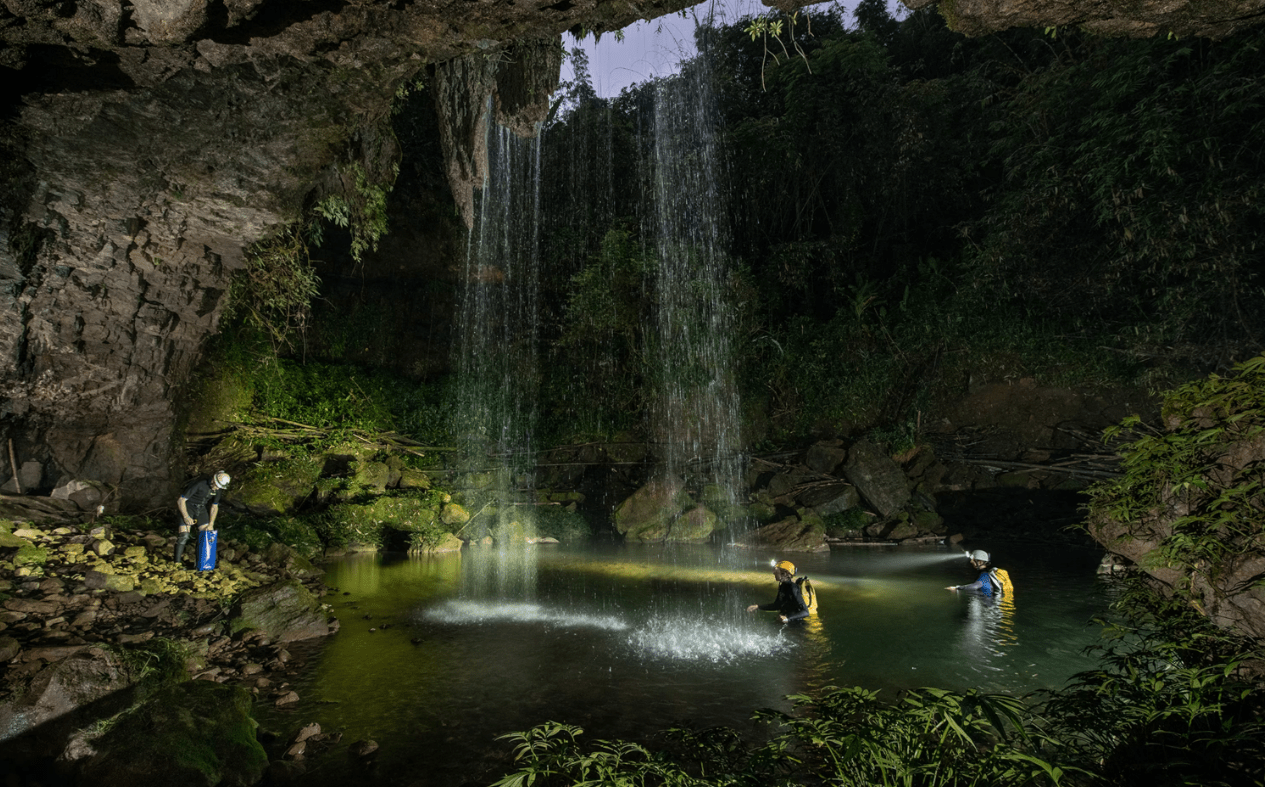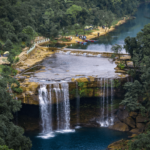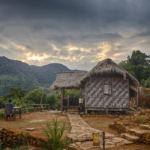As I stood before the enigmatic entrance of the cave, a singular thought crossed my mind: I wish I could explore inside! Krem Chympe, or the Chympe Caves, loomed before us, its secrets cloaked in shadow. From a distance, the faint murmur of the Chympe Waterfalls was audible. The colossal cave’s entrance, adorned with surreal limestone formations, was framed by lush greenery, with water droplets cascading into the turquoise pool below. Sunlight streaming into the cave made it appear almost magical—a truly mesmerizing sight.
We were perched on a massive boulder in front of Krem Chympe, the fifth longest cave in India. Every time I think I’ve seen the best that Meghalaya has to offer, the region surprises me with something even more remarkable!
Krem Chympe – What Is It?
In the Khasi language, “Krem” means “cave.” Meghalaya is renowned for its numerous caves, including well-known ones like Mawsmai and Arwah in Cherrapunjee. The Jaintia Hills also host several relatively unexplored caves, with Krem Chympe being a notable example.
Krem Chympe – A Natural Symphony
Krem Chympe is a testament to nature’s artistry, where water intersects with limestone and sandstone hills. This river cave is particularly intriguing. It’s a resurgent cave, where an underground river reemerges at Krem Chympe’s mouth. Locals refer to this spot as Sielkan – Pielkhlieng Pouk.
Inside Krem Chympe, the river flows horizontally. In 2016, the Meghalaya Adventurers’ Association mapped about 19 km of the cave, although much remains to be explored. The cave features nearly 50 natural dams formed by high concentrations of calcium carbonate in the water, creating sedimentary deposits along pool edges. Some of these dams are up to 12 meters high, with pools reaching depths of 8 meters.
As with many limestone caves, Krem Chympe is home to fascinating limestone formations, including lotus-shaped structures at the pool’s edges. Additionally, it houses the world’s largest cave fish and a large bat colony, similar to the Siju Caves in Garo Hills.
How to Reach Krem Chympe, the 5th Longest Cave in Meghalaya
Navigating to Krem Chympe
Upon preparing for our visit to Krem Chympe and the Chympe Waterfalls, I turned to Google Maps for directions. Unfortunately, the results were inconclusive, listing places like Khaddum and Khaddum Shympe Falls instead of Krem Chympe. This confirmed my suspicion that Google Maps often falls short in Meghalaya, having previously directed me to incorrect roads in Shillong.
For those planning a visit, seeking local guidance is advisable.
Location of Krem Chympe
Krem Chympe is situated in the East Jaintia Hills of Meghalaya. From Shillong, travel to Lumshnong. After crossing the Lumshnong Toll Plaza, take a left turn towards Brishyrnot village. The road conditions are poor, so a vehicle with high ground clearance is recommended.
Reaching Chympe
From Brishyrnot, you can either trek or use a 4-wheel drive. The trekking trail to Chympe is about 5 km, though distances in trekking can vary. The initial descent leads to a hanging bridge over the Wah Lukha River, followed by an uphill trail through the forest. At a junction, you can choose the path to Chympe Waterfall or Krem Chympe. The 4×4 vehicle can only go so far; beyond this point, a trek is necessary.
4-Wheel Drive to Krem Chympe
Alternatively, take a 4-wheel drive to Khaddum village, about 5 km from Brishyrnot. The drive involves crossing the Wah Lukha River and navigating through dense forests, including bamboo areas. After about 45 minutes, reach Khaddum village and continue to the junction point.
Our Experience
On our fifth or sixth visit to Meghalaya, we explored both well-known and offbeat locations in Khasi Hills. This time, we ventured into Jaintia Hills and Garo Hills, arriving in Jowai the previous day. Our offbeat road trip continued towards Lumshnong the next morning.
We drove through Meghalaya’s industrial areas, where cement factories are prevalent. These factories, while providing employment and improving infrastructure, also contribute to environmental concerns. After nearly two hours, we reached Lumshnong, where we followed signs to various caves. The rough, bumpy road to Brishyrnot took about 30 minutes.
In Brishyrnot, a small village known for its broomstick cultivation, we had lunch and then embarked on an off-road journey in a 4-wheel drive to Chympe.
Chympe Waterfall
We encountered stunning scenery as we approached Chympe Waterfall, which was surrounded by lush greenery. The sight of the water cascading into a pristine pool was breathtaking—almost like a perfect wallpaper. We enjoyed our lunch by the waterfall, where locals were cleaning the area. They offered us tea, served in bamboo cups, enhancing our experience.
Krem Chympe
After spending time at the waterfall, we hiked to Krem Chympe. The trail was challenging, requiring climbing over tree trunks and navigating tricky sections. The cave entrance, framed by massive boulders, was a spectacular sight. To access the cave, we had to jump across boulders and squeeze through rocks. Inside, the cave features multiple pools, with depths increasing gradually. Swimming skills are essential, and a life jacket or snorkeling gear is recommended.
Returning to Khaddum
After exploring Krem Chympe, we returned to Khaddum village and then to Brishyrnot. We had tea and snacks before making the long drive back to Jowai, arriving after nearly three and a half hours. The day was exhausting but incredibly rewarding. Chympe Waterfalls and Krem Chympe are memories we will cherish.
Best Time to Visit Krem Chympe
The ideal time to visit Krem Chympe is between November and March when the weather is cool and dry, making trekking trails more accessible.
Things to Remember While Visiting Krem Chympe
- Transport: Public transport options are limited. It’s best to use local guides if traveling by car from Shillong to Jowai. For personal vehicles, a high ground clearance car is recommended.
- Preservation: Avoid littering. Carry out all food and drink waste.
- Safety: If you don’t know how to swim, do not venture into the water. Use life jackets if you plan to swim or explore the cave’s pools.


